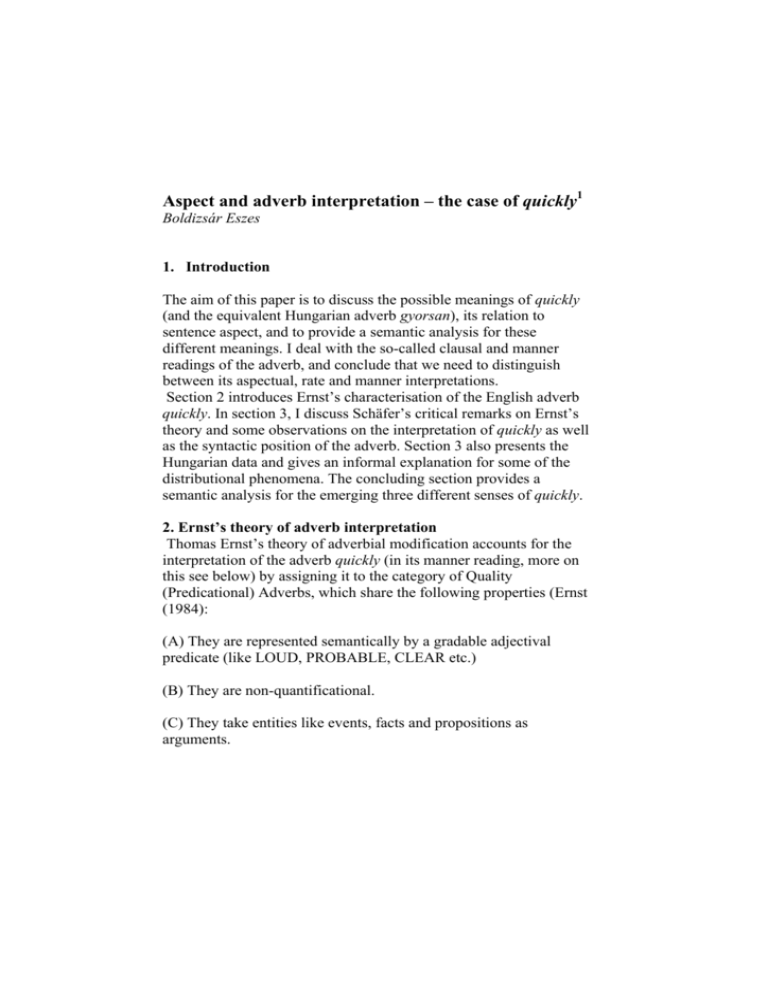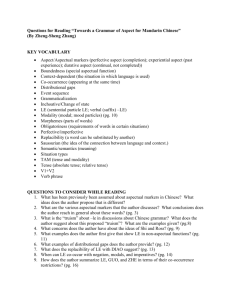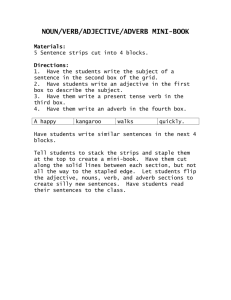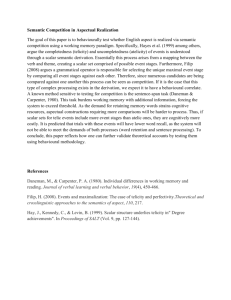Aspect and adverb interpretation – the case of quickly
advertisement

Aspect and adverb interpretation – the case of quickly1
Boldizsár Eszes
1. Introduction
The aim of this paper is to discuss the possible meanings of quickly
(and the equivalent Hungarian adverb gyorsan), its relation to
sentence aspect, and to provide a semantic analysis for these
different meanings. I deal with the so-called clausal and manner
readings of the adverb, and conclude that we need to distinguish
between its aspectual, rate and manner interpretations.
Section 2 introduces Ernst’s characterisation of the English adverb
quickly. In section 3, I discuss Schäfer’s critical remarks on Ernst’s
theory and some observations on the interpretation of quickly as well
as the syntactic position of the adverb. Section 3 also presents the
Hungarian data and gives an informal explanation for some of the
distributional phenomena. The concluding section provides a
semantic analysis for the emerging three different senses of quickly.
2. Ernst’s theory of adverb interpretation
Thomas Ernst’s theory of adverbial modification accounts for the
interpretation of the adverb quickly (in its manner reading, more on
this see below) by assigning it to the category of Quality
(Predicational) Adverbs, which share the following properties (Ernst
(1984):
(A) They are represented semantically by a gradable adjectival
predicate (like LOUD, PROBABLE, CLEAR etc.)
(B) They are non-quantificational.
(C) They take entities like events, facts and propositions as
arguments.
(D) They are almost always composed of an adjective plus the suffix
-ly in English.
Within the category of Predicational Adverbs, we can distinguish the
so-called Pure Manner Adverbs (PMA), which share the following
semantic characteristics:
(a) PMAs usually involve perceptual qualities: light, sound, taste,
physical action and so on.
(b) PMAs modify the perceptible dimensions of an event directly,
while the manner readings of other Quality Adverbs only indirectly.
Consider a typical PMA like loudly and compare it to a so-called
mental attitude adverb like sadly (Schäfer 2001):
(1)a. John walked loudly off the stage.
b. John walked sadly off the stage.
Whereas loudly denotes a perceptual quality, sadly does not modify
the event but instead expresses a property of the agent’s mental
attitude. Thus (1)a. characterizes the walking event, while (1)b.
contains a psychological adjective, which is simply a quality adverb.
We can also distinguish between the so-called clausal and manner
readings of quality adverbs.
(2)a. Alice has cleverly answered the questions.
b. Alice cleverly has answered the questions.
c. Alice has answered the questions cleverly.
(2)a. is ambiguous between the readings (2)b. and (2)c. (2)b. is the
subject-oriented clausal reading (‘It was clever of Alice to have
answered the questions’), which is compatible with her having given
stupid answers, while (2)c. displays the manner reading, which is
consistent with the possibility that answering the questions at all was
stupid of her.
Ernst mentions two important differences between the manner and
the clausal readings. One is that the manner reading requires the
manifestation of the quality expressed by the adverb, while the
clausal reading is typically either a speaker-oriented or a subject(agent-) oriented one. Besides agentivity, the clausal reading
involves the agent exercising control over the eventuality by
choosing or avoiding some action, so in a situation where (2)b. is
true, the act of answering warrants positing more cleverness in the
agent (as opposed to cleverness exhibited in the content of the
answer) than the average norm for answering events.
This leads to the second difference, which concerns the ground of
comparison in the two cases and can be accounted for on the
supposition that the comparison classes used to interpret the two are
different. These comparison classes are sets of actual and possible
events that provide the basis for comparing the quality of a particular
event with other events of the same type, or alternatively with other
unspecified possible events. This means that the comparison class
for manner readings consists of so-called Specified Events that
receive the same description as the one forming the basis of
comparison. In examples (2)a-c., the manner reading requires that
Alice’s answer should be compared to other possible answers with
respect to the manifested property, whereas the clausal reading
requires that her answer should be compared to other possible
events, especially to not answering the questions at all.
As I will argue in the paper, the clausal and the manner readings of
quickly can be analyzed with the help of scale structures, which
accords with the basic assumptions of Ernst’s theory of adverbial
modification. However, as there is a third possible temporal
interpretation of quickly, which cannot be categorized in terms of the
clausal vs. manner dichotomy, we need to make some further
distinctions to see how this adverbial interacts with verbs of different
aspectual types.
3. The interpretations of the adverb quickly
3.1. Categorization issues
Ernst (2002) only slightly modifies the details of his previous
framework and makes a distinction between the pure manner and the
aspectual meanings of quickly. However, Schäfer (2001) raises an
important critical point about Ernst’s categorization, arguing that
quickly cannot be a prototypical (core) pure manner adverb. He gives
grounds to his claim pointing out that, although quickly satisfies the
semantic criteria for Pure Manner Adverbs on its manner reading, it
may receive another, metaphorically extended temporal (aspectual)
interpretation as well.
On Ernst’s categorization, this aspectual meaning of quickly is
distinct from the pure manner reading. Schäfer does not accept this
claim because, as he notes, if we adhered to Ernst’s original criteria,
quickly would neither count as a manner adverb under this latter
reading (because it has nothing to do with the perceptible qualities of
the event), nor a quality (predicational) adverb. Rather, it should be
considered a functional adverb of time. However, aspectual quickly
would not resemble other quantity adverbs like immediately or soon,
because these do not have a pure manner reading as well. This
aspectual interpretation of quickly cannot be a clausal reading in the
strict sense of the term either, because quickly cannot be paraphrased
by predicating the related adjective QUICK of the state of affairs
described in the rest of the sentence, as (3)a-c. show:
(3)a. John quickly lifted his arm.
b. ‘John was quick in lifting his arm.’
≠ c. ‘John lifted his arm and that (fact) was quick.’
Schäfer argues that the temporal interpretation of quickly is a
metaphorical construction. Contrary to Ernst, who excludes quickly
from the class of PMAs on the basis of this temporal meaning,
Schäfer concludes that we must distinguish between core PMAs like
loudly or tightly and other PMAs like quickly, slowly or quietly
whose meanings can be metaphorically extended to obtain another
reading.
On the supposition that the temporal meaning of quickly is
metaphoric, we may expect that synonyms and antonyms of quickly
do not have the same interpretational possibilities. This prediction is
borne out in English: as Schäfer observes, the adverb fast, a word
which is a close in meaning to quickly lacks the temporal (aspectual)
reading and cannot occur pre-verbally.
(4) *John fast lifted his arm.
Based on these observations, Schäfer proposes an underspecified
semantic form for the base meaning of quickly, so that he can derive
the manner and the clausal (aspectual) readings by introducing
certain operators into the compositional process.
Although I do not relate these different meaning, my analysis in
section 4 uses Schäfer’s representation of the aspectual reading of
quickly as a starting point for developing a semantic analysis.
3.2. Three senses of quickly
Following Travis (1988), Tenny (2000) observes that like some other
adverbs, quickly is ambiguous between the aspectual and another –
rate or manner – reading, depending on its syntactic position.
(5a) Quickly, John will be arrested by the police.
(5b) John quickly will be arrested by the police.
(5c) John will quickly be arrested by the police.
(5d) John will be arrested by the police quickly.
In (5a) and (5b) quickly modifies the time of the preparation
preceding the arrest, so these sentences mean that the arrest is going
to happen very soon. In (5c) and (5d), it is the process of arrest that
quickly modifies, so they mean that the rate or manner of the arrest
will be hurried.
Tenny proposes a theory of semantic zones to account for the
distribution and the corresponding readings of adverbs. She argues
that quickly is in fact three-way ambiguous depending on the
semantic zone where it modifies events:
Type of modification
1. pure manner modification:
2. true rate modification
3. aspectual modification:
Semantic zone
core event
(cf. celerative II in Cinque (1999))
core event
middle aspect
(cf. celerative I in Cinque (1999))
According to Tenny, (6) has two readings, given in (6)a. and (6)b.:
(6) Mary moved quickly to the window.
a. Mary moved her body in quick motions while progressing to
the window, although her traversal of the path to the window may
not have been a fast one. (pure manner modification)
b. Mary’s traversal of the path to the window was fast. (true rate
modification)
Compare also (6) with (7) which can only be interpreted as
describing the manner Mary moved to the window.
(7) Mary moved to the window quickly.
Schäfer’s ‘temporal reading’ corresponds to Tenny’s ‘aspectual
modification reading’, which is illustrated in (8):
(8) Mary quickly moved to the window.
However, as Thompson (2006) points out, when quickly is preposed,
it may have a rate reading, too in addition to the aspectual reading.
So (5a) (and also (5b)) may mean that the process of the arrest was
quick. The only interpretation preposed quickly cannot have is the
manner reading.
This raises the possibility that quickly in its rate reading modifies in
the higher, middle aspect zone, like aspectual quickly. Thompson
(referring to the rate reading for perfective sentences as the “whole
event” reading) argues that quickly on the rate reading is adjoined to
AspP, while on the manner reading it is adjoined to VP (or vP). She
further claims that the lower attached quickly with a manner reading
modifies only atelic events, while quickly on its rate reading can
modify only telic events.
Thompson’s syntactic analysis is supported by linear order facts as
well. When an unambiguous manner adverb like carefully precedes
quickly, it may have both the manner and the rate readings,
depending on the context.
(9) John built the house carefully quickly.
However, when carefully follows quickly, the only reading available
is the manner reading:
(10) John built the house quickly carefully.
Following Thompson (2006), we may schematically draw up the
following tree structures for the two types of modification.
(11)
AspP
Adv
quickly
AspP
DPj
Asp’
the house Asp
builti
vP
v
ti
VP
tj ti
(12)
AspP
DPj
the house
Asp’
Asp
vP
builti v
VP
ti
VP
Adv
tj ti
quickly
As É. Kiss (this volume) shows, the word order with respect to the
corresponding Hungarian adverb gyorsan is different, insofar as the
occurrence of gyorsan is restricted when ordered with a real degree
adverb like félig (half): according to a supposedly universal
hierarchy, manner adverbs precede degree adverbs, whereas
frequency adverbs precede manner adverbs:
(13)a. János gyorsan félig megcsinálta a házi feladatot.
John quickly half PRT-did
the homework.
‘John quickly did half of the homework.’
b. ??János félig gyorsan megcsinálta a házi feladatot.
John half quickly PRT-did
the homework
‘John quickly did half of the homework.’
By contrast, the postverbal placement of the so-called predicational
adverbs like gyorsan is unrestricted:
(14)a. János megcsinálta gyorsan félig a házi feladatot.
John PRT-did quickly half the homework
‘John did quickly half of the homework’.
b. János megcsinálta félig a házi feladatot gyorsan.
John PRT-did
half the homework quickly.
‘John has done half of the homework quickly.’
Assuming the framework presented by É. Kiss, we can say that
manner, frequency and degree adverbs are all called ‘predicate
adverbials’, because they are located within a special phrasal
projection PredP (for details see this É. Kiss, this volume). However,
as I will try to argue in the rest of this paper, adverbial modification
interacts with focus and aspect, so the question whether it involves
the aspectual projection AspP and the focus projection FP in
Hungarian also emerges. The differences in the possible
interpretations of gyorsan with respect to focus and some aspectual
types like the progressive are more salient in Hungarian due to the
presence of the telicizing verbal particles.
3.3 Interaction with aspect
So far we have distinguished three supposedly different meanings
of quickly: a manner, a (true) rate and an aspectual one. Actually, the
issue is more complex than it would seem at this point. Kearns
(2005) argues that certain predicates modified by quickly differ in
telicity, depending on the position of the adverb. While preverbal
quickly forces a telic reading if it is available, post-verbal quickly
allows both a telic and an atelic reading. Kearns calls this latter
reading a “manner” interpretation, but in fact this may be either the
manner reading or the one which Tenny identified as the true rate
meaning of the adverb, depending on the meaning of the verb.
Kearns observes that the postverbal position of quickly is
compatible with either a bounded or an unbounded event, so the verb
eat in example (15) below may be interpreted either way, and it
would seem that quickly may be interpreted either as a manner or as
a rate adverbial. Thompson, however, as noted, claims that the only
available reading for quickly in atelic sentences is the manner
reading. In fact, in my view this is just a terminological issue: if we
replace the ‘whole event’ reading which cannot apply to atelic
(imperfective) events by definition in favor of the ‘rate reading’
which may be applied to atelic events, too, then the rate reading may
also be available with atelic sentences.
A question that needs to be answered in this connection concerns
the aspectual status of telic verbs of movement with an endpoint.
Caudal and Nicolas (2005) argue that these verbs (like X drove to X,
for example) cannot be gradual – they should be represented as
atomic change-of-state events, because they cannot be modified by
completely or finish. Thus we have conflicting evidence that pull us
in different directions: on the one hand, we should be able to account
for the possibility of modification with quickly, where the rate
meaning of the adverb clearly requires a development portion of the
event, but we have to do justice to the data of modification with
completely and the like. I cannot resolve this tension in this paper, so
I will continue with the assumption that these verbs are non-atomic.
To round off the discussion of aspectual differences, let us consider
the two possible interpretations of (15), an example borrowed from
Kearns (2005). (15a), the temporal interpretation of the verb eat is
unbounded, as the completion of the event can be denied without
contradiction. By contrast, once quickly is attached in a preverbal
position as in (15b), the denial of completion of the event would be
contradictory.
(15) John ate the apple quickly.
(15)a. John ate the apple quickly, but Mary snatched it away before
he finished it. – Unbounded (imperfective), manner or rate reading
b. ??John quickly ate the apple, but Mary snatched it away
before he finished it. – Bounded (perfective), aspectual reading
Used with quickly, the change-of-state verb dry also alternates
between process and accomplishment senses depending on the
position of the adverb (see Kearns 2005 for details):
(16)a. The clothes dried quickly, but were still quite damp when I
checked them.
b. ??The clothes quickly dried, but were still quite damp when I
checked them.
The following table gives an overview of the different
interpretations of the adverb quickly depending on its possible
positions.
Preverbal (incl. Preposed) AspP-adjoined
Postverbal, VP (PredP)-adjoined
Aspectual reading
Rate reading
Manner reading
Manner reading
Rate reading
The next section surveys the Hungarian data bearing on the various
interpretations of gyorsan and the different interpretations of the
adverb, showing how they depend on its co-occurrence with verbs
belonging to different aspectual classes and focus.
3.4 The Hungarian data
This section will introduce the relevant data concerning the
interaction of the adverb with the different aspectual verb classes,
and compare the distribution of gyorsan in sentences containing
activities, accomplishments, achievements and so-called punctuals.
Of course, a number of other factors besides verbal meaning may
also affect the resulting aspectual interpretation, but here I will
largely ignore these to keep things simple.
The adverb gyorsan is incompatible with states, so I will not
consider this aspectual class, neither will I discuss certain (mainly
post-verbal) placements of the adverb which are generally regarded
as marginally acceptable. I will use the labels M, R and A as short
for manner, rate and aspectual readings respectively.
First, consider how gyorsan is interpreted when it modifies an
intransitive verb of motion:
(17) János [FocP gyorsan [PredP futott (három órán át)]]. M, R
John
quickly
ran
three hours for
‘John ran quickly (for three hours).’
Gyorsan in (17) is in focus position, where it can be interpreted as
specifying the manner or the rate of John’s motion. We may explain
the absence of the aspectual reading on the supposition that the
preceding or preparatory time needed for the aspectual interpretation
is absent in activities. This view about imperfective atelic sentences
is supported by the substitution of the aspectual adverbs rögtön (‘at
once’) or azonnal (‘immediately’) for gyorsan. These expressions
can only modify the preparatory time.
(18)a. *János rögtön futott három órán át.
John at.once ran three hours for
‘John at once ran for three hours’.
(18)b. *János azonnal
futott három órán át.
John immediately ran three hours for.
‘John immediately ran for three hours.’
At this point we may also discern an interesting parallel between the
aspectual reading of gyorsan and these aspectual adverbs. Kiefer
(1994) observes that rögtön or azonnal can disambiguate certain
sentences that are ambiguous between an imperfective and a
perfective interpretation.
(19) Amikor csengettek, János (éppen) telefonált.
when bell-rang John (just) phoned
‘When the bell rang, János was speaking on the phone.’
(20) Amikor csengettek, János rögtön /azonnal
telefonált.
when bell-rang John at.once/immediately phoned
‘When the bell rang, János made a call immediately.’
The main clause in (19) has progressive aspect, as attested by the
modifier éppen (‘just’), and the event time of the activity described
in the main clause includes that of the subordinated time clause. By
contrast, the aspect of the main clause in (20) is perfective and the
events described in the main clause and the subordinated time clause
are understood as consecutive. It seems that the function of rögtön
(‘immediately’) in (20) is to relate the event time of a perfective
clause it is contained in to a certain time immediately preceding it,
which may be explicitly expressed or implicitly inferred from the
context. When interpreted aspectually, the function of gyorsan looks
very similar:
(21) Amikor csengettek, János gyorsan telefonált a rendőrségre. A
when bell-rang John quickly phoned the police-to
‘When the bell rang, John quickly called the police.’
Let us now return to atelic verbs. Consider the transitive change-ofstate verb like szárít (‘dry’) in (22):
(22) A szél [FocP gyorsan [PredP szárította (a kiterített ruhákat)]]. R
the wind
quickly
dried
the hung-up clothes.
‘The wind quickly dried the clothes on the line.’
It would be impossible to interpret this sentence on the manner
reading of gyorsan, because the wind is a non-human natural force
instead of an agent, so the manner of drying events by the wind
cannot be modified. In fact, it cannot possibly have the aspectual
reading either for reasons explained above. Of course, the so-called
change-of state verbs that denote non-agentive intransitive processes
like érik (‘ripe’) or szárad (‘dry’) also lack the manner meaning:
(23)a. A paradicsom gyorsan érett. R
the tomato
quickly ripened
‘The tomato ripened quickly.’
b. A ruha
gyorsan száradt. R
the clothes quickly dried
‘The clothes dried quickly.’
By contrast, gyorsan modifying an accomplishment with an
incremental theme and an agent may receive the rate and the
aspectual readings.
(24) János gyorsan felépítette a házat. R, A
John quickly PRT-built the house
‘John built the house quickly.’
Atelic sentences containing so-called route verbs with an associated
path of the motion (for details see Tenny (1994)) are ambiguous
between a manner and a rate meaning of gyorsan, as (25) illustrates:
(25) János gyorsan mászott a létrán. M, R
John quickly climbed the ladder-on
‘John climbed the ladder quickly.’
The adverb gyorsan has the following interpretations in sentences
containing a particleless verb with a telicising directional NP:
(26)a. János [FocP gyorsan [PredP ment (az ablakhoz)]]. M, R
John
quickly
moved the window-to
‘John quickly moved to the window.’
b. János [AspP gyorsan [AspP[PredP az ablakhoz [PredP ment]]]] M,R,A
John
quickly
the window-to
moved
‘John quickly moved to the window.’
We may account for the availability of the aspectual reading in
(26)b. by assuming that gyorsan sits in Spec, FocP in (26)a.,
whereas in (26) b. it is attached to AspP, and the DP az ablakban (‘in
the window’) is in the specifier position of PredP, a projection below
AspP.
Compare the positions of non-focussed gyorsan in sentences
containing an accomplishment with a telicising verbal particle and a
Goal-denoting NP.
(27)a. János gyorsan felment az emeletre. M, R, A
John quickly up-went the first.floor-to
‘John went upstairs quickly.’
b. János felment gyorsan az emeletre. M, R, A
John up-went quickly the first.floor-to
‘John went upstairs quickly.’
By contrast, the aspectual meaning is not available when the adverb
is in focus.
(28) János [FocP gyorsan [PredP ment fel az emeletre]]. M, R
John
quickly
went up the first.floor-to
‘John went upstairs ‘quickly.’
The following sentences illustrate that gyorsan in progressive
sentences containing accomplishments with a directional NP has
the manner and the rate readings.
(29) János (éppen) gyorsan ‘ment fel a lépcsőn az emeletre...
John (just) quickly went up the stairs-on the first.floor-to
(prog) M, R
‘John was going upstairs quickly when...’
(29) has progressive aspect, which in Hungarian requires the explicit
expression of a reference time in the past with a subordinate clause
to count as a complete utterance. Being the object of the verb megy
(go)’ the stairs provide a measure for the climbing event, and the
adverb, besides qualifying John’s motion as quick (manner), may
also mean that the rate of the climbing the stairs was quick compared
to other climbing events.
gyorsan with change-of-state accomplishments has the following
readings:
(30)a. Péter gyorsan megfőzte a csirkét. R, A
Peter quickly PRT-cooked the chicken
‘Peter cooked the chicken quickly.’
b. A csirke
gyorsan megfőtt. R, A
the chicken quickly PRT-cooked
‘The chicken cooked quickly.’
c. Péter gyorsan főzte
meg a csirkét. R
Peter quickly cooked PRT the chicken
‘Peter cooked the chicken quickly.
Also consider two sentences with achievements, to be discussed
below:
(31)a. János [AspP gyorsan [AspP [PredP felért
(az emeletre)]]]. A
John
quickly
PRT-reached the first.floor-to
‘John reached upstairs quickly.’
b. János [FocP gyorsan [PredP ért
fel (az emeletre)]]. A
John
quickly
reached PRT the first.floor-to
‘John quickly reached upstairs.’
Finally, the case of punctuals (achievement-like verbs without a
preparatory phase) reveals an interesting property of gyorsan:
(32)a. #János gyorsan megbotlott.
John quickly PRT-stumbled
‘John quickly stumbled.’
b. #János gyorsan tüsszentett.
John quickly sneezed.
‘John quickly sneezed.’
c. A bomba gyorsan felrobbant. A
the bomb quickly PRT-exploded
‘The bomb exploded quickly.’
(32)a. and (32)b. are unacceptable because when aspectual gyorsan
is used with agentive verbs, it requires that the agent have control
over the event to some extent, a precondition which is not met in
(32)a. and (32)b., as these sentences describe typical involuntary
actions. Perhaps an appropriate context for interpreting (32)c. would
be a situation where a bomb disposal expert has control over
detonating the bomb. In this scenario, gyorsan can only have the
aspectual reading.
Note also that gyorsan can be used with non-agentive intransitive
accomplishment verbs, too. Consider (33a-c):
(33)a. A paradicsom gyorsan megérett. R, A
the tomato
quickly PRT-ripened
‘The tomato ripened quickly’.
b. A ruha gyorsan megszáradt. R, A
the clothes quickly PRT-dried
‘The clothes quickly dried.’
These sentences may express that either the rate or the termination of
the accomplishment was quick. Gyorsan may also occur with their
transitive causative counterparts, with natural forces conceptualized
as causers of these events:
(34)a. A sok napfény gyorsan megérlelte a gyümölcsöt. R, A
the much sunshine quickly PRT-ripened the fruit
‘A lot of sunshine quickly ripened the fruit.’
b. A szél
gyorsan megszárította a ruhát. R, A
the wind quickly PRT-dried the clothes
‘The wind quickly dried the clothes.’
3.5 Summary of the distributional facts
Having surveyed the available readings of the adverb gyorsan, we
may formulate the following generalizations:
(35) Generalizations about gyorsan
a) (focussed) gyorsan has manner and rate readings in sentences
containing activity verbs.
b) gyorsan has manner and rate readings in progressive sentences
containing an associated path of motion.
c) focussed gyorsan has rate and manner readings in perfective
sentences containing accomplishment verbs of motion.
d) non-focussed gyorsan has rate, manner and aspectual readings in
perfective sentences containing accomplishment verbs of motion.
e) a sentence containing an accomplishment which is a change-ofstate verb may receive the aspectual and the rate but not the
manner readings with non-focussed gyorsan.
f) gyorsan has only the aspectual reading in perfective sentences
containing achievements.
h) gyorsan has only the aspectual reading with punctuals expressing
controllable events.
Based on these observations, the following table shows summarizes
the interpretational possibilities of the adverb gyorsan.
NonNonprogressive progressive
atelic(imper telic
Progressive Achievement
atelic/telic
Punctual
(controllable)
Focussed
Nonfocussed
fective)
M, R
---
(perfective)
M, R
M, R
(M+agentive), M, R
R, A
A
3.6 Two kinds of aspectual reading?
According to (35d), non-focussed gyorsan has both the rate and the
aspectual readings in perfective sentences containing
accomplishments. The aspectual reading of gyorsan in telic
sentences often carries the implication that the path of the movement
was traversed quickly. At this point, by choosing appropriate
contexts it may be shown that the two readings are independent of
each other. Suppose that John ate a small apple at a leisurely pace. In
this scenario, (36) may be truthfully asserted:
(36) János lassan ette az almát, mégis gyorsan megette.
John slowly ate the apple still quickly PRT-ate
Lassan: R, gyorsan: A
‘John ate the apple slowly, still he ate it up quickly.’
Here the slow rate of the eating event, expressed by the adverb
lassan (‘slowly’) is contrasted with the quick finishing of eating up
the apple indicated by gyorsan, which shows that gyorsan here has
the aspectual sense.
This might suggest that we ought to distinguish between the
terminative and the inceptive aspectual senses of gyorsan. The clear
cases for the inceptive aspectual meaning seem to be those where
gyorsan is used with certain inchoative verbs in Hungarian or with
the inchoative construction elkezd V-ni ‘start to V’ (A-I here
indicates the inceptive aspectual reading):
(37)a. János gyorsan elindult haza. A-I
John quickly PRT-left home
‘John left for home quickly.’
A
b. Péter gyorsan feldühödött. A-I
Peter quickly PRT-got-angry
‘Peter got angry quickly.’
(38) Péter gyorsan elkezdett
futni
/vacsorázni/olvasni. A-I
Peter quickly PRT-started run-INF/dine-INF /read-INF
‘Peter started to run/eat his dinner/read quickly.’
In (38), gyorsan modifies the VP elkezd V-ni, but it may also be
inserted between the verb elkezd and the infinitive, in which case it
modifies the rate or the manner of the event expressed by the
infinitive.
(39) Péter elkezdett
gyorsan futni. M, R
Peter PRT-started quickly run-INF
‘Peter started to run fast.’
Nevertheless, when used with verbs of motion and change of state
which function as telic predicates, the inceptive meaning of gyorsan
cannot be separated from the terminative sense clearly, because telic
predicates expressing a bounded change of state or a bounded
change of location involve complex events consisting of a (durative
or momentary) process and a resultant state/resultant location. The
process is denoted by a verbal predicate in Hungarian, while the
resultant state or location is signaled by the presence of resultative or
terminative verbal particles (É. Kiss 2006a). In these cases, gyorsan
modifies the whole telic predicate, and the sentence locates the
whole complex event with its result state relative to a reference time.
Besides sentences containing achievement verbs, the terminative
reading of gyorsan is also salient in the construction befejez + NP
‘finish + NP’, where the NP is a nominalized form of a verb
denoting an activity, or a quantized object. The latter is a
metonymical construction where the missing verb may be inferred
from the context:
(40) János gyorsan befejezte
az olvasást. A-T
John quickly PRT-finished the reading
‘John quickly finished reading.’
(41) János gyorsan befejezte
a könyvet. A-T
John quickly PRT-finished the book
‘John quickly finished the book.’
Notwithstanding some phenomena that seem to support the
distinctness of these two aspectual meanings, I will consider the
aspectual use of gyorsan uniform, because in most cases it involves a
relation between a preceding reference time and a culmination point
or alternatively, the start of the event. As for those sentences where it
does not seem to function this way, like in examples (40)-(41), it can
be understood as qualifying the length of an interval spanning a
period extending from a certain reference time to the end of a
preparatory period of the event.
3.7 The possible readings of gyorsan
I will assume that gyorsan (or quickly) in sentences containing
achievements behaves only as an aspectual modifier. Consider (42):
(42) Mari gyorsan felért
a csúcsra.
Mary quickly PRT-reached the top
‘Mary quickly reached the top.’
A
It is obvious that in (42) quickly (or gyorsan) cannot modify the
manner of reaching the top, because taken in itself, a momentary act
of reaching cannot be said to be slow or quick. I suppose it cannot
modify the rate of Mary’s climbing prior to her reaching the top
either, because this activity is not strictly part of the meaning of the
verb. Instead, here gyorsan refers to a presupposed preparatory phase
of the event of Mary’s reaching the top. The sentence asserts that the
time that elapsed between Mary’s having started climbing the hill, or
between the start of the final phase of her climbing and the result
state of her being at the top is short – that is, the preparatory phase of
Mary’s reaching the top was quick. In addition, it may pragmatically
imply that the rate at which Mary performed the preparatory phase
(consisting in her climbing the hill) was quick as compared to other
possible climbing events.
We may suppose some kind of pragmatic reasoning like this going
on here: the speaker asserted that a short time elapsed between the
start of the climbing (or alternatively, the start of some final phase of
climbing) and the result of being at the top, so Mary must have been
climbing quickly, because she could not have reached the top
otherwise in a time shorter than the average for climbing events.
Note that thus we have to distinguish two kinds of preparation: a
preparatory time which does not form part of the event structure and
is not presupposed in general, and a preparatory phase whose
existence is presupposed by achievements in general.
3.8 gyorsan in progressive sentences
Property (35b) fits several event-based semantic analyses of the
progressive, e.g. Landman (1992). Landman gives the truth
conditions of progressive sentences within a possible-world
framework, claiming that they denote unfinished, partially completed
eventualities, so-called stages of possibly complete events. On this
interpretation we can see why progressives do not allow the
aspectual reading. This reading involves the notion of a preparatory
phase or a period preceding the event – as we have seen, according
to Schäfer (2001) this is what the adverbial quickly modifies in its
aspectual use. However, progressives denote a partial, ongoing
eventuality with possible outcomes whose preparatory phases (if
there are any) are not available for modification. So we may
conclude that the aspectual reading of gyorsan is acceptable only in
clauses describing complete events, i.e. with non-progressive
accomplishments, achievements and punctuals.
3.9 gyorsan in focus position
According to (35c) and (35e), one difference between the focussed
and non-focussed sentences is the absence of the aspectual reading in
the case of focussed gyorsan. This means that the preceding time
interval is not available for modification when the adverb is focussed
in perfective sentences containing telic accomplishments. Although I
have no ultimate explanation for the fact that this reading is not
allowed in the focus position, I think it may be helpful to compare
the behaviour of gyorsan with its antonym lassan (‘slowly’), which
must be in focus in Hungarian to receive a manner reading, sharing a
common characteristic of other expressions (like ritkán (‘rarely’),
rosszul (‘wrongly’), kevesen (‘few’) etc.) with a ‘negative meaning’
component. Unlike most of these negative expressions, it may also
occur unaccented pre-verbally, preceding the particle-verb complex
(see example (44)), and in this case it has only the aspectual
modification meaning2:
(43) János [FocP lassan [PredP ment (oda (az ablakhoz))]] R, M
John
slowly
went PRT the window-to
‘John moved to the window slowly.’ (with slow motion)
(44) János lassan odament az ablakhoz. A
John slowly PRT-went the window-to
‘John slowly moved to the window’. (The event of John’s going
to the window took a long time to begin.)
In order to distinguish the presupposed part from the asserted
content in sentences containing the focussed adverb, let us consider
(45):
(45)Nem igaz, hogy János[FocP gyorsan[PredP ment (fel (az emeletre))]]
not true that John
quickly
went up the first.floor-to
‘It is not true that John went upstairs quickly.’
The presupposed part, which can be formulated roughly as ‘John
went upstairs in some manner or at some rate’ is preserved under
negation. What is asserted in a sentence containing the focussed
adverb is that this manner or rate was quick as compared to some
other possible goings upstairs: following Rooth (1996), we may
suppose that these possible events form the alternative set of focus.
When focussed, the adverb lassan, the antonym of gyorsan does not
have the aspectual reading either – it can modify the time preceding
the beginning of an event only in a non-focussed position. That is,
we cannot use gyorsan in its aspectual reading contrastively because
the appropriate contrast with lassan is not available in focus. Of
course, the question of why neither of these adverbs can occur in
focus still needs to be explained.
The possibility of the aspectual reading with gyorsan (both as
focussed and as non-focussed) in sentences containing achievements
like felér needs some elucidation. As I have already explained, we
can distinguish two kinds of intervals which precede the event times.
The first kind of interval is attached only contingently to the event,
which means that it may or may not be involved in the interpretation
of certain aspectual verb classes, depending on its relevance. This
interval is typically either inferred from the context or from the
reference time specified in an appropriate time clause.
The second kind of interval, which is a preparatory phase, is
presupposed by achievements in general, as they describe the
reaching of a result state or culmination that is preceded by this
phase. Used with achievements, gyorsan qualifies this preparatory
time, rather than simply a contingent interval that precedes the event.
Thus when it occurs with achievements, the aspectually interpreted
gyorsan does have an aspectual antonym lassan with which it may
be contrasted in focus:
(46)a. János gyorsan ért
fel a lépcsőn. A
John quickly reached PRT the stairs
‘John reached upstairs quickly’.
b. János lassan ért
fel a lépcsőn. A
John slowly reached PRT the stairs
‘John reached upstairs slowly.’
4. A scalar semantics for quickly
I will use the semantic framework of Kennedy and McNally (1999)
to give a detailed analysis of the meaning of quickly. The general
idea behind an analysis of this sort resembles Ernst’s theory where
adverbs are interpreted as expressions with a semantic representation
containing a corresponding adjective and an appropriate comparison
class, whether consisting of specified or other, non-specified events.
However, as I will argue, the different meanings of gyorsan require
basically different kinds of comparison classes and ways of
comparison with different scale structures, so the adjective QUICK
involved in the semantic representation of the sentences containing
quickly is really a shorthand for a complex relation, to be formulated
in terms of scales and these comparison classes. This means that we
need to flesh out the relevant scale structures in more detail to give a
suitable meaning representation for all three attested meanings of
quickly.
The basic idea behind the scalar analysis of so-called gradable
adjectives (like dry, tall, warm etc.) may be summarized as follows.
Adjectives of this type map their arguments onto abstract
representations of measurement, which can be conceived
as degrees. These degrees in turn may be formalized as
points or intervals totally ordered along some
dimension. (e.g., dryness, height, temperature etc.).
Each set of degrees ordered in this way corresponds to
a scale. We can then interpret the propositions
containing the gradable adjectives like relations
between degrees on a scale. If we use a domain with a
structure like this, we may interpret these adjectives
as relations between individuals and degrees.
The first question to be discussed concerns the type of scale by
which the senses of quickly are to be interpreted. Although Kennedy
and McNally do not discuss the adjective quick, they mention its
synonym fast explicitly while making several interesting
observations about some similar adjectives, which also apply to
quick.
The adjective quick is a relative gradable adjective like tall or deep.
‘Gradable’, understood here in a narrow sense, means that the
standards used by quick do not involve any minimal and maximal
degrees. This feature contrasts it with absolute adjectives like awake
(minimum standard) or full (maximum standard). Thus quick
incorporates an open scale with no minimal or maximal elements.
Although as an adjective, quick is an NP modifier appearing in
several metonymic constructions, I think it is plausible to claim that
its characterizing properties transfer to the related gradable relative
adverb quickly. As Kennedy and McNally convincingly show, the
behavior with the maximizing modifier absolutely, along with the
fact that fast (and also quick) allows for PPs that introduce the
comparison class provide evidence for the relative nature of quick:
(47)a. ??John is absolutely quick.
b. ??John is absolutely slow.
(48) This baby is quick (for a two-year old).
Of course, these properties must be taken into account in specifying
the scale structures.
The following gives the details of a scalar analysis of quickly,
complemented with some definitions from the event semantic
framework of Krifka (1992), where events and times form complete
semi-lattices with the two-place operation ⊔ on the domain U of
events.
(49)a. ⊔, the sum operation is a function from U×U to U that is
idempotent, commutative and associative.
b. The temporal trace function τ maps events to their run-times.
∀e,e’[τ(e) ⊔τ(e’) = τ(e⊔e’)]
c. The structure of time intervals has atomic reference, the atoms are
the time points (Ta).
Some further definitions specify the part, the proper part relations
and the notion of a P-atom. This is the set of atomic events of larger
events under a description P. x is a P-atom with respect to predicate
P if and only if it has property P but has no proper parts with
property P.
(50) ∀x, y[x⊑y ↔ x⊔y = y] (part relation (partial order))
(51) ∀x, y[x ⊏ y ↔ x ⊑ y ∧ ¬x = y] (proper part (strict partial
order))
(52) ∀x, P[ATOM(x, P) ↔ P(x) ∧ ¬ ∃y[y ⊏ x ∧ P(y)] (x is a Patom)
4.1. The manner and the rate readings
I will start with discussing the manner reading of gyorsan, which is
available with activities and accomplishment verbs of motion. At
first we might suppose that an analysis would be adequate which
uses a scale structure with degrees ordered along the dimension of
speed for the minimal parts (which may be considered as separate
bodily motions). However, this would result in an incorrect
prediction, considering that the minimal parts make up the whole
event, so that their speed values add up and determine the rate of the
event, which means that on this supposition the rate reading would
depend asymmetrically on the manner reading. Obviously, we have
to make sure that this does not happen. One possible solution would
be to suppose that the manner-type modification involves the agent
of the event, whose bodily motion is at issue, while under the rate
reading the adverb relates the whole event to a contextual standard
specified by other events of the same type.
To spell out this idea, let us introduce a new notion, the AgentAtom of an event. Agent-Atoms are atomic parts which stand in a
specific relation to the Agents of activities or accomplishments. Thus
we may conceive the agent as composed of atomic parts
corresponding to the minimal events, and in doing so we can
attribute the intensity of the particular bodily motions to these
minimal agent-parts. The definition given below assumes an
ordering defined over the consecutive temporal parts of the agent,
where there is a morphism from sub-events to agent parts:
(53) AG-ATOM(x’, e, P) =def [(AG (e, x, P) ∧ x’ ⊂ x ∧ ∃!e’
[ATOM(e, e’, P) ∧ AG(x, e’, P)]
So in this analysis the manner reading of quickly is represented with
reference to the atomic agent of the sub-event and a contextually
determined comparison class consisting of atomic agents of other
events characterised under the same description like the one at issue.
The adverb quickly on its manner reading takes an event and a
degree argument, yields the minimal (atomic) agents of the event
under a description, and compares the degree of these minimal agent
parts’ intensity of bodily motion to minimal agent parts of other
events of motion, so that the sentence asserts that all these minimal
agents possess a higher degree of bodily motion than the average for
minimal parts in general.
Of course, in a more precise analysis we should allow for a certain
degree of vagueness as the exact number of the ‘sub-agents’ that
have to move with a degree above average cannot be exactly
specified, but for the sake of simplicity here I will use universal
quantification over them.
As I have already noted, when the modification with quickly results
in a manner reading, the adverb takes a verbal predicate as its
argument together with its implicit degree argument characterizing
the intensity of bodily movement. This argument is bound by default
as having an unspecified value when the sentence does not contain
any adverb to modify it. When an adverb is inserted, it does not only
relate this argument to a contextually given average value. The
following gives an overview of the semantic composition of the
sentence radical ‘John run quickly.’
(54) [quicklyM] → λΦλxλd1λd2λe[Φ(x)(d2)(d1)(e) ∧ ∀ x’[AGATOM (e, x’, F) → d(x’) >C(d)])]
(55)a. [[move] V]→ λxλd1λd2λe[move(e)(x) ∧ AG-ATOM(x)(d1)
∧ rate(e)(d2)]
b. [John] → j
c. [run] ([John]VP) → λd1λd2λe[move(j)(e) ∧ AG-ATOM(j)(d1) ∧
rate(e)(d2)]]
d.[quicklyM] ([ (move (John)VP]) → λd1λd2λe
λe[move(x)(d2)(d1)(e) ∧ AG-ATOM(j)(d1) ∧ rate(e)(d2) ∧ d1>
C(d)])]
I will assume that another difference between the manner and the
rate readings of quickly lies in the types of their corresponding
scales. Caudal and Nicolas (2005) argue that verbs may have two
different types of scales associated with them, such as a) Intensity
(dry, widen) or alternatively b) Quantity (eat). My analysis differs
from theirs insofar as I suppose that verbs of motion incorporate both
of these scale types, but they associate them with different
arguments, i.e. Intensity goes with the atomic agents of sub-events
while Quantity with the event as a whole. Thus the manner reading
of quickly uses a scale of Intensity, whereas the rate reading uses a
scale of Quantity. This also means that we cannot derive either
reading from the other.
Below I provide the interpretation for the rate reading. Here we
have to provide an appropriate comparison class for the rate reading
in order to make sure that the events to be compared are of the
proper kind. There are two options: either the meaning of the verb
incorporates either an open scale, or a closed scale (quantity). In the
first case, there are only sub-events to be compared with respect to
their quantity, so to specify the average run-time of these events we
should define an equivalence relation on the set of sub-events that
yields the equivalence class containing events with the same length
of path as sub-events of the original event. In this case, the degree
argument for the rate reading (d2) serves to compare the run-times of
the atomic sub-events, so the resulting proposition asserts that the
run-times of these sub-events are less than the average value. When
quickly is used with a verb of motion with an associated path or other
types of ‘measuring-out’ expressions (see Tenny (1994) for details),
the corresponding scale is closed and the resulting interpretation
should differ accordingly. Of course, in both cases the comparison is
made with events of the same type as the original, that is, specified
events. (56) gives the interpretation of quickly for the rate reading
with atelic events of motion. This formulation is intended to replace
the “rate” relation shown in the preceding formulas.
(56) [quicklyR] →λΦλxλd1λd2λe [[Φ(x)(d2)(d1)(e) ∧
∀e’[(ATOM, e’, Φ) → (d2,e’) φC(d) ] ]]
4.2 The aspectual interpretation of quickly
Schäfer provides an analysis for the aspectual reading of quickly,
which serves as my starting point in this section. Consider (57a) and
(58a) and their paraphrases (57b) and (58b).
(57)a. John lifted his arm quickly.
b. ‘John lifted his arm in a quick way.’
(58)a. John quickly lifted his arm.
b. ‘John was quick in lifting his arm.’
Whereas quickly in (57a) specifies the manner of the lifting action, in
(58a) it qualifies the time span after which the activity occurred. This
reading involves a contextually given reference time, and locates the
event with respect to it. So (57a) may be given a more detailed
paraphrase: ‘The time that elapsed from a contextually given point in
time to the onset of the action/event which consists in John’s lifting
his arm was short.’
Schäfer assigns the semantic representation (59) to the temporal
reading of quickly and (60) to the whole sentence (58a).
(59) λPλe[P(e) ∧∃τ[τ = [tr, BEG(e)] ∧ SHORT(τ)]
(60) ∃y[ARM(John, y) ∧ LIFT (John, y, e) ∧ ∃τ[τ = [tr, BEG(e)]
∧SHORT(τ)]]
Here tr represents the contextually given reference time (an instant)
and τ is a time span, so the second conjunct of (60) says that the time
span leading up from the reference time to the beginning of the event
is short. The speaker may specify the reference time by using a time
clause, like in (61).
(61) When the bell rang, John quickly lifted his arm.
In what follows I would like to develop Schäfer’s analysis for the
aspectual reading of quickly by spelling out the meaning of SHORT
(that is, the aspectual equivalent of QUICK) in the above formula.
Let us start with an observation of Partee (1973), who pointed out
that the interpretation of immediately (an aspectual adverb) interacts
with tense in a sentence like (62).
(62) If Susan comes in, John will leave immediately.
The immediate future is measured from the time of Susan’s coming
in. In (62) the present tense is interpreted as a bound variable which
is anaphorically connected to the present tense of the if-clause. The
occurrence of present tense in the if-clause is not deictic, it has no
specific reference.
Similarly to immediately, the reference time for aspectually
interpreted gyorsan may be contextually specified:
(63) János gyorsan elkezdett olvasni.
‘John quickly started reading.’
Or else the reference time may be anchored to an antecedent time
given in a time-clause:
(64) Amikor Mari elmosogatott, János gyorsan elkezdett takarítani.
‘When Mary had done the washing up, John quickly started to
clean the room.’
As Schäfer notes, using quickly in its aspectual reading, the speaker
asserts that the time interval between the reference time and the
beginning of the event is a short one in comparison with the time
intervals of similar events that form the comparison class.
I will build on this intuition in giving a more detailed interpretation
for this kind of reading. To achieve this, let me introduce the
definitions of right and left boundaries as in (65)a. and b.
(65)a. LB(i,i’) iff i∩i’ ≠∅ ∧ ¬∃i’’: i’’< (i∩i’) ∧ i’’⊆i’
b. RB(i, i’) iff i∩i’ ≠∅ ∧ ¬∃i’’: i’’> (i∩i’) ∧ i’’⊆i’
Under the aspectual reading of quickly, the relevant intervals are
compared with respect to the closeness of their right boundary (RB)
to a left boundary (LB) of a given event. Instead of a two-place
relation, I will use two functions (LB, RB), which map the respective
boundaries to an interval as their value. The reference interval may
be given by a time-clause or it may become salient in the context.
(66) [quickly] → λΦλxλd1λd2λe [Φ(x)(d2)(d1)(e) ∧
(DIFF(LB(τ(e)), RB(i))) < C))]
The relevant comparison class consists of events of the same type
like the one to be compared, and the comparison class for specifying
the contextually given average value may be defined like this:
(67) {RBτ(e) – LB(i’): e ∈U}
Here i and i’ are free variables. The variable i is either bound by a
reference interval which is made available by a time clause or its
value is given by the relevant context of the utterance. The variable
i’ is needed to characterize the earliness of the events in the
comparison class and therefore it is different in each case.
Under this analysis, verbs of achievement would require special
treatment, because being instantaneous and therefore practically
identical with their culmination, the right and left boundaries of their
run-time collapse into an instant. In addition, the relevant reference
intervals in their case must always be the corresponding preparatory
periods preceding their culmination. The analysis given here should
therefore be modified accordingly to accommodate this aspectual
type.
5 Conclusion
I have shown in outline how the interpretations for the different
senses of quickly can be given, based on Ernst’s theory of adverbial
modification supplemented by specific scale structures in a scalar
semantic framework. The overall result is an interpretation where
two different senses of quickly are given distinct scales, while the
third, aspectual sense uses a comparison class containing the runtime values of intervals. The nature of the respective scales are
different, just like the required types of comparison classes. In this
approach, the aspectual interpretation is not derived from a basic
meaning representation but represents a distinct sense for quickly.
The interaction with aspect and focus in Hungarian offers a direction
for further research.
Notes
1
I would like to thank Huba Bartos, Anikó Csirmaz, Katalin É. Kiss, Christopher
Piñón, Balázs Surányi, and Anne Tamm for their helpful comments on the earlier
version of this paper.
2
The adverb lassan (‘slowly’) has a pragmatic function in Hungarian, which
seems unrelated to its central meanings. Used this way, it can be paraphrased by
the ideje, hogy... („it is time to V”) collocation, or another adverb lassanként
(’before long’) and implies that the speaker is of the opinion that the action or
process which it modifies is about to take place. In this use, it may also occur in
modal constructions with a special word order. Consider (a) and (b):
(a) Lassan (már)
el kellene mennem.
slowly (already) PRT should go-INF
’It is time for me to leave’.
(b) Lassan elmegyek.
slowly PRT-go-1SG
’I am going to leave.’
(a) or (b) cannot be interpreted as specifying the manner or rate of my leaving.
This pragmatic function somewhat resembles the aspectual interpretation, but is
different from the standard aspectual sense. The speaker may utter (a) or (b) only
when (s)he is actually about to take his leave.








